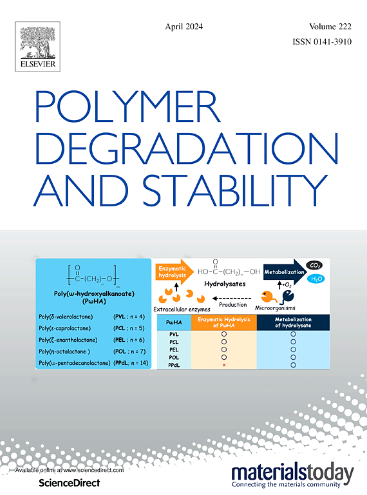通过热机械脱硫回收三元乙丙橡胶:分批和连续操作
IF 6.3
2区 化学
Q1 POLYMER SCIENCE
引用次数: 0
摘要
热机械脱硫是实现三元乙丙橡胶循环经济的一种可能的解决方案,因为它可以去除硫化胶中的共价交联,从而得到与未硫化橡胶混合物相似的材料。本文对硫磺硫化的三元乙丙橡胶进行了热机械刺激处理:a)在双辊轧机和内部混合器中加工;b)双螺杆挤出。Horikx 的分析表明,交联密度降低了 75%,但聚合物链几乎没有降解。由此产生的脱硫酸盐和非脱硫橡胶屑被添加到原始橡胶混合物中,得到再生橡胶含量为 0、25、50、75 和 100 wt% 的样品。脱硫酸盐含量高达 50 wt%的再硫化胶保持了原始橡胶的拉伸强度,模量略有增加。最终,批量脱硫取得了最有希望的结果,挤出脱硫也比使用未脱硫橡胶屑更有利。交联密度和形态测试也支持这些发现。本文章由计算机程序翻译,如有差异,请以英文原文为准。
Recycling of EPDM rubber via thermomechanical devulcanization: Batch and continuous operations
Thermomechanical devulcanization is a possible solution for the circular economy of EPDM rubber, as it removes covalent crosslinks from vulcanizates, resulting in a material similar to uncured rubber mixes. In this paper, sulfur-cured EPDM rubber was treated with thermomechanical stimuli: a) processing on a two-roll mill and in an internal mixer, and b) twin-screw extrusion. Horikx's analysis indicated a 75 % decrease in crosslink density with little polymer chain degradation. The resulting devulcanizates and non-devulcanized rubber crumb were added to the original rubber mix, yielding samples with 0, 25, 50, 75 and 100 wt% recycled rubber contents. Revulcanizates with up to 50 wt% devulcanizate content retained the tensile strength of the original rubber with a slight increase in modulus. Ultimately, batch devulcanization had the most promising results, and extrusion devulcanization was also more beneficial than using non-devulcanized rubber crumb. Crosslink density and morphological tests also support these findings.
求助全文
通过发布文献求助,成功后即可免费获取论文全文。
去求助
来源期刊

Polymer Degradation and Stability
化学-高分子科学
CiteScore
10.10
自引率
10.20%
发文量
325
审稿时长
23 days
期刊介绍:
Polymer Degradation and Stability deals with the degradation reactions and their control which are a major preoccupation of practitioners of the many and diverse aspects of modern polymer technology.
Deteriorative reactions occur during processing, when polymers are subjected to heat, oxygen and mechanical stress, and during the useful life of the materials when oxygen and sunlight are the most important degradative agencies. In more specialised applications, degradation may be induced by high energy radiation, ozone, atmospheric pollutants, mechanical stress, biological action, hydrolysis and many other influences. The mechanisms of these reactions and stabilisation processes must be understood if the technology and application of polymers are to continue to advance. The reporting of investigations of this kind is therefore a major function of this journal.
However there are also new developments in polymer technology in which degradation processes find positive applications. For example, photodegradable plastics are now available, the recycling of polymeric products will become increasingly important, degradation and combustion studies are involved in the definition of the fire hazards which are associated with polymeric materials and the microelectronics industry is vitally dependent upon polymer degradation in the manufacture of its circuitry. Polymer properties may also be improved by processes like curing and grafting, the chemistry of which can be closely related to that which causes physical deterioration in other circumstances.
 求助内容:
求助内容: 应助结果提醒方式:
应助结果提醒方式:


